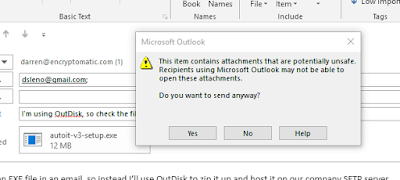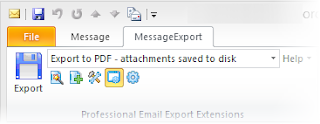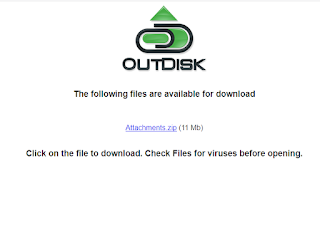File Transfer Protocol, or #FTP, is a venerable old protocol with a legacy stretching
as far back as 1971, when Abhay Bhushan wrote the spec for it. With concerns slowly mounting about security over the years, FTP has given way to other file transport methods that securely handle passwords and encrypt transfers.
We originally released OutDisk FTP in 2006, and over the years it has not been one of our more successful products. The complexity of configuring FTP accounts and servers was a hurdle for some. Given the amount of time our support team spent troubleshooting our customer's person FTP servers, we learned firsthand that OutDisk is a niche tool that is not right for everyone. In fact, most people should use an file transfer add-in from a service like Dropbox, and not try to roll their own service.
Yet, our more hardcore OutDisk users (generally more technically capable with solid IT experience) have found ways to solve an array of problems with it, many of which we never envisioned. At their urging we have updated OutDisk for Outlook 2019. The emphasis of OutDisk moving forward will be on use of the SFTP Secure File Transport Protocol which adds encryption layer providing security far beyond old FTP.
If you are one of the persistent hardcore OutDisk users who wouldn't take "maybe" as answer, this update is for you.
What is OutDisk SFTP for Outlook?
It's been awhile, so we may as well start at the beginning.
OutDisk SFTP is a tool for transferring files from your Windows desktop to your remote server. It can be used from the Windows desktop, but most people who choose OutDisk do so because of it's tight integration with the Microsoft Office Outlook interface.
When you send an Outlook email with file attachments, OutDisk SFTP Outlook add-in will, either automatically or by your manual selection, remove the attachments from the email and upload them to your server. It then inserts your custom message and a https link into the email so the recipient can download the attachments.
The benefit of using OutDisk is that it makes your emails smaller and more likely to be delivered to the recipient's inbox. You can also choose to automatically compress and encrypt the file attachments.
People who use OutDisk are generally in a small to mid-sized company, although we have had large electrical utilities use it. What they all seem to have in common is a) they want to simplify sending attachments for their Outlook users, b) they don't want their users uploading company documents to their private Dropbox account or some other 3rd party file storage system, and c) maybe they want to take some load off of email servers and storage, or have a legal need to keep control of documents, or have some kind of other specific use that had them searching Google for an FTP add-in for Outlook.
Here's some pictures of the OutDisk SFTP integration with Outlook.
How does OutDisk SFTP work from the user's perspective?
After setting up your SFTP server, and installing OutDisk SFTP with their log-in credentials, your users should find it simple to use. They just create an Outlook email as they normally would, attach a file to the email and send it (as they normally would).
Here's an email with an EXE file attachment that I prepared to send to myself:
 |
| Email with exe file attachment.See the OutDisk tool bar integration upper right corner. |
Here's the normal message from Outlook reminding me that I can do that.
 |
| Outlook warning about potentially unsafe file attachments. |
And now, here's the email as it arrived in my Gmail Inbox.
Finally, here's the https webpage the recipient sees when they follow the link. And yes, you can change the text that OutDisk inserts into the email. It's fully customizable.
Yes, you can change the logo to your company logo.
We have provided a test SFTP service in OutDisk, just so you can try it right away. File size is limited, and we sweep through and delete everything quite often, so please do not use it in production.
In Conclusion
We are very pleased that we can keep OutDisk compatible with the current versions of Microsoft Windows and Office. If you think you might be a candidate to use Outdisk, or if it may be a fit for a project you're working on, you can learn more and get the free trial at the
OutDisk product home page.
By the way, those are my real email addresses. I love to hear from customers. Drop me a line and say hello.












